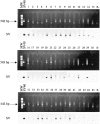Simian virus 40 sequences and expression of the viral large T antigen oncoprotein in human pleomorphic adenomas of parotid glands
- PMID: 12368186
- PMCID: PMC1867276
- DOI: 10.1016/S0002-9440(10)64389-1
Simian virus 40 sequences and expression of the viral large T antigen oncoprotein in human pleomorphic adenomas of parotid glands
Abstract
Simian virus 40 (SV40) sequences of the early region coding for the large T antigen (Tag) oncoprotein were investigated in DNA samples from human pleomorphic adenoma (PA) of parotid glands. Specific SV40 sequences were detected, by PCR and filter hybridization with an internal oligoprobe, in 28 of 45 (62%) human PA specimens. None of the DNA samples from 11 normal salivary gland tissues was SV40-positive. DNA sequence analysis, carried out in all PCR amplified products from SV40-positive PA specimens, confirmed the SV40 specificity and indicated that PCR products had a sequence not distinguishable from SV40 DNA wild-type strain 776. SV40 Tag expression was revealed by immunohistochemistry with the specific monoclonal antibody Pab 101 in PA thin sections with a highly sensitive technical approach which retrieved the nuclear viral oncoprotein in 26 out of 28 (93%) samples previously found SV40-positive by PCR. Detection of SV40 sequences and Tag expression in human PA suggests that this oncogenic virus may play a role as a cofactor in the onset and/or progression of this benign neoplasm, or that SV40 DNA could replicate and express the Tag in PA cells.
Figures


References
-
- Farina A, Pelucchi S, Carinci F: Evidence of bimodal distribution of age in patients affected by pleomorphic adenoma of the parotid gland. Oral Oncol 1997, 33:288-289 - PubMed
-
- Farina A, Pelucchi S, Grandi E, Carinci F: Histological subtypes of pleomorphic adenoma and age-frequency distribution. Br J Oral Maxillofac Surg 1998, 37:154-155 - PubMed
-
- Carinci F, Farina A, Pelucchi S, Calearo C, Fini-Storchi O, Merlo R, Pastore A: Parotid gland carcinoma: 1987 and 1997 UICC T classifications compared for prognostic accuracy at 5 years. Eur Arch Otorhinolaryngol 2001, 258:150-154 - PubMed
-
- Carinci F, Farina A, Pelucchi S, Calearo C, Pastore A: Parotid gland carcinoma: surgical strategy based on local risk factors. J Craniofac Surg 2001, 12:434-437 - PubMed
-
- Toida M, Balazs M, Mori T, Ishimaru JI, Ichihara H, Fujitsuka H, Hyodo I, Yokoyama K, Tatematsu N, Adany R: Analysis of genetic alterations in salivary gland tumors by comparative genomic hybridization. Cancer Genet Cytogenet 2001, 127:34-37 - PubMed
Publication types
MeSH terms
Substances
LinkOut - more resources
Full Text Sources

